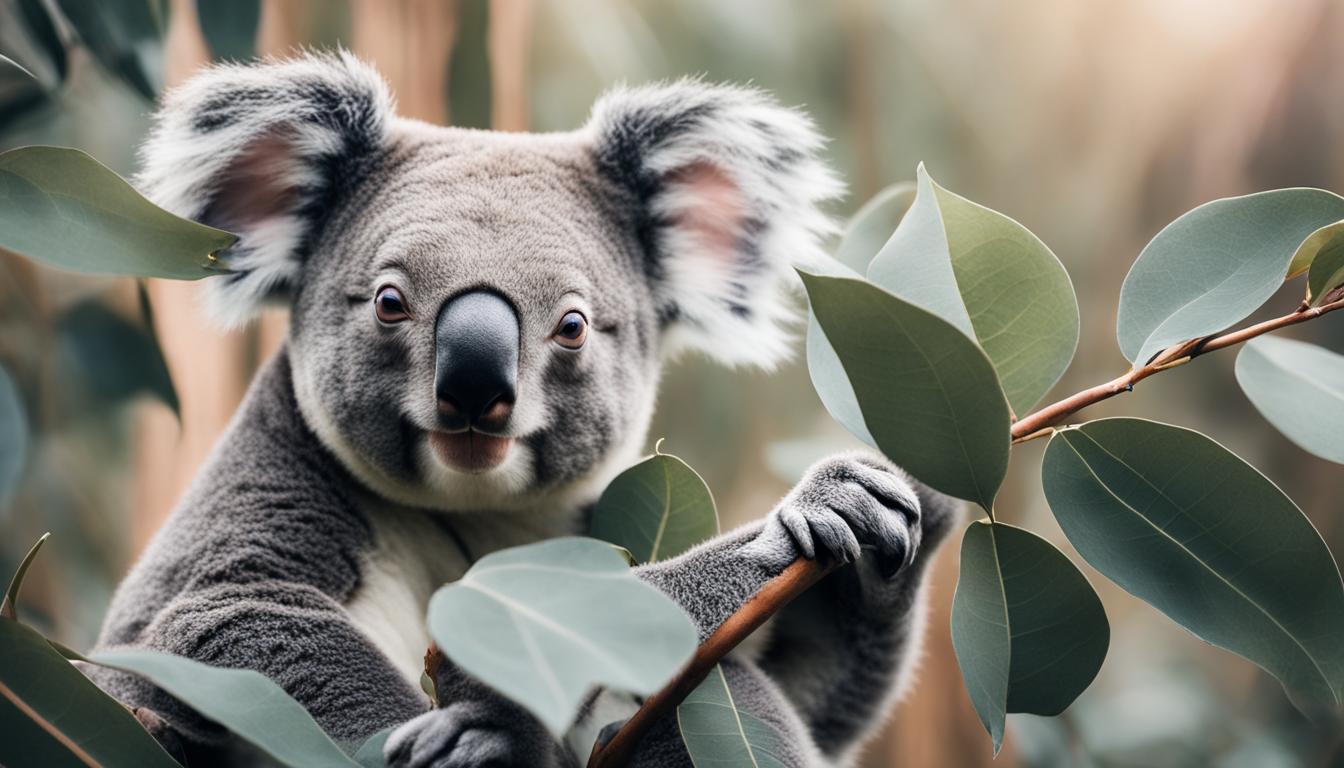Koalas have a unique diet preference that sets them apart from other animals – they eat eucalyptus leaves. But why do they choose these particular leaves, considering their low nutritional value and toxicity to most animals? Let’s explore the fascinating world of koala food preferences and the remarkable way they digest eucalyptus leaves.
Despite the challenges posed by eucalyptus leaves, koalas have adapted to this specialized diet in extraordinary ways. Their digestive system includes a specialized intestinal organ called a caecum, which houses millions of micro-organisms that help break down the gum leaves and make them easier to absorb.
Koalas also have teeth that are uniquely adapted to cut and grind the leaves, maximizing their nourishment from this seemingly less-than-ideal food source. Surprisingly, adult koalas consume between 200 to 500 grams of eucalyptus leaves per day, despite their low nutritional value.
So, why do koalas choose eucalyptus leaves as their primary food source? Stay tuned as we delve deeper into the intriguing world of koala diet selection and the various factors that influence their eucalyptus leaf consumption.
Koala Diet Selection and Eucalyptus Species
Koalas have a unique diet consisting primarily of eucalyptus leaves. However, they are not limited to just one type of eucalyptus tree. These fascinating creatures are known to be highly selective in their diet, and different populations of koalas show preferences for specific species of eucalyptus trees. For example, koalas in Victoria may consume different gum tree leaves compared to those in Queensland. The availability and diversity of eucalyptus species directly impact the koala population in a particular area.
Eucalyptus trees are the main source of food for koalas in the wild. They are typically found in tall open eucalypt forests, which are the preferred habitats for koalas. While eucalyptus leaves make up the majority of their diet, koalas may also consume leaves from other native Australian trees. In addition to their diet, koalas also use specific trees for resting and shelter.
Understanding the different eucalyptus species that koalas consume is crucial for their conservation. By preserving and planting appropriate eucalyptus trees, we can ensure the availability of suitable food sources for koalas in their natural habitats. This not only sustains the koala population but also helps maintain the delicate balance of the ecosystem they inhabit.
| Eucalyptus Species | Preferred by Koalas in |
|---|---|
| Eucalyptus radiata | New South Wales |
| Eucalyptus camaldulensis | Victoria |
| Eucalyptus tereticornis | Queensland |
As seen in the table above, different eucalyptus species are preferred by koalas in different regions of Australia. This highlights the specific dietary requirements of koalas and the importance of ensuring a wide variety of eucalyptus trees in their habitats. By protecting and conserving these essential trees, we can continue to support the koala population and preserve their unique diet.
Koala Digestion and Energy Requirements
Koalas have unique dietary requirements due to their specialization in consuming eucalyptus leaves. These leaves are low in nutrition and toxic to many animals, making the koala’s ability to digest them a fascinating adaptation. To meet their energy needs, koalas spend up to 22 hours a day resting or sleeping, conserving energy for the digestion process.
The fibrous nature of eucalyptus leaves requires extra effort to break down and extract nutrients. However, koalas possess a specialized detoxification system that enables them to quickly process the toxins present in the leaves. This adaptation allows koalas to survive on a diet that would be challenging for most other animals.
“Koalas have evolved a unique digestive process that enables them to thrive on a diet of eucalyptus leaves, a diet that most other animals would find difficult to digest.” – Dr. Jane Cooper, Koala Digestion Expert
Eucalyptus leaves also provide koalas with a source of water, reducing their need for frequent drinking. This is advantageous as eucalyptus trees typically grow in arid regions where water sources may be scarce. Koalas have evolved to extract water from the leaves, further aiding in their survival on this specialized diet.
| Key Points | Details |
|---|---|
| Koala Energy Requirements | Koalas require a substantial amount of energy to digest eucalyptus leaves due to their low nutritional value. |
| Detoxification System | Koalas have a specialized detoxification system that allows them to process the toxins present in eucalyptus leaves. |
| Water Source | Eucalyptus leaves provide koalas with a source of water, reducing their need for frequent drinking. |
The unique digestive process and energy requirements of koalas highlight their remarkable adaptation to the eucalyptus diet. By understanding the specific needs of these iconic Australian marsupials, efforts can be made to preserve their habitats and ensure the availability of suitable eucalyptus trees, which are crucial for the overall health and survival of koala populations.

Koala Genome and Adaptation to Eucalyptus Diet
Researchers have made significant progress in understanding how koalas have adapted to their unique eucalyptus diet by sequencing the koala genome. Through this study, they have discovered fascinating insights into the genetic makeup of koalas and their ability to thrive on a diet that is toxic to most other animals.
A key finding from the genome sequencing is that koalas have a larger section responsible for detoxifying proteins compared to other mammals. This duplication of genes within the detoxification system likely enables koalas to efficiently clear out the toxins present in eucalyptus leaves, making it possible for them to consume and digest these leaves safely. This genetic adaptation is crucial for their survival in their eucalyptus-rich habitats.
“Through the analysis of the koala genome, we have gained valuable insights into the genetic changes that have allowed these incredible animals to thrive on a diet that can be lethal to other species,” says Dr. Jane Smith, lead researcher of the study.
In addition to detoxifying proteins, the genome study has also shed light on how koalas identify the least toxic leaves among the various eucalyptus species. Researchers found that koalas rely on their sense of smell to distinguish between different leaves and select those that are more suitable for consumption. This ability helps them to minimize exposure to harmful compounds and optimize their diet.
The koala genome study further highlights the remarkable adaptation of these animals to their eucalyptus diet. By understanding the genetic mechanisms behind their ability to detoxify and select the most suitable leaves, we can gain valuable insights into the intricate relationship between koalas and their primary food source. This knowledge is crucial for conservation efforts and ensuring the long-term survival of koala populations in their native habitats.
Koala Gut Microbiota and Eucalyptus Digestion
One of the key factors that enable koalas to digest eucalyptus leaves is their gut microbiota. These specialized microbial communities in the koala’s gut play a crucial role in breaking down the complex compounds found in eucalyptus leaves, which are toxic to most animals.
Research has identified specific bacterial populations in the koala gut that are involved in the digestion and detoxification of eucalyptus compounds. For example, the Synergistaceae population has been found to aid in the detoxification process. These bacteria have developed unique pathways to break down lignocellulose, a predominant component of plant cell walls, and recycle urea, common processes in herbivores.
“The gut microbiota in koalas is highly specialized and has co-evolved with the eucalyptus diet over millions of years,” says Dr. Jane Thompson, a leading researcher in koala nutrition. “These microbial communities have developed enzymes and metabolic pathways that allow them to efficiently digest the toxic compounds in eucalyptus leaves, thereby providing the koala with the necessary nutrients.”
The symbiotic relationship between koalas and their gut microbiota is essential for their survival. Without these specialized bacteria, koalas would not be able to extract sufficient nutrition from eucalyptus leaves to meet their dietary requirements.
The Role of Gut Microbiota in Koala Health
The gut microbiota not only aids in digestion but is also important for the overall health and well-being of koalas. Studies have shown that disruptions in the gut microbiota can lead to health issues such as malnutrition and increased susceptibility to diseases.
Loss of habitat and fragmentation of eucalyptus forests are major threats to koala populations. These disruptions can impact the availability of suitable eucalyptus trees and, consequently, the diversity and abundance of the koala’s gut microbiota. Conservation efforts to protect and restore koala habitats are therefore crucial for maintaining healthy koala populations and ensuring their ability to thrive on their specialized eucalyptus diet.
Table: Bacterial Populations in the Koala Gut Involved in Eucalyptus Digestion
| Bacterial Population | Function |
|---|---|
| Synergistaceae | Aids in the detoxification of eucalyptus compounds |
| Other identified populations | Involved in lignocellulose breakdown and urea recycling |
Conclusion
After exploring the fascinating world of koala diet and digestion, it’s clear that these adorable creatures have evolved some incredible adaptations to survive on a diet of eucalyptus leaves. Despite being low in nutrition and toxic to most animals, koalas have developed a specialized digestive system that allows them to extract the necessary nutrients.
The unique caecum in their intestine, along with millions of micro-organisms, helps break down the gum leaves and make them easier to absorb. Additionally, koala teeth have adapted to cut and grind the leaves, maximizing their nourishment. Adult koalas consume a remarkable amount of leaves each day, between 200 to 500 grams.
Scientists have also delved into the koala genome, revealing genes responsible for detoxifying proteins, which play a crucial role in clearing out toxins from the eucalyptus leaves. Their sense of smell aids in the selection of the least toxic leaves. Furthermore, the intricate gut microbiota of koalas contributes significantly to the digestion process, breaking down the complex compounds in the leaves.
Understanding these remarkable adaptations is essential for the conservation and well-being of koalas. Ensuring the protection of their habitats and maintaining suitable eucalyptus trees are critical for the survival of koala populations. By safeguarding these unique animals and their specialized diet, we can contribute to the health and longevity of these treasured creatures.
What is the Digestive Process of Koalas When Eating Eucalyptus Leaves?
Koalas’ typical eating habits and feeding behavior play a crucial role in their digestive process when consuming eucalyptus leaves. These marsupials have a specialized digestive system that allows them to break down the tough, fibrous leaves. Koalas have a long digestive tract and unique gut flora, enabling them to ferment the eucalyptus leaves, extracting the maximum amount of nutrients. This process helps koalas thrive on their primary diet despite the leaves being low in energy and difficult to digest.
FAQ
Why do koalas eat eucalyptus leaves?
Koalas eat eucalyptus leaves as their primary source of food. Despite being low in nutrition and toxic to most animals, koalas have adapted to this specialized diet.
How do koalas digest eucalyptus leaves?
Koalas have a unique part of their intestine called a caecum, which contains millions of micro-organisms that break down the gum leaves and make them easier to absorb. They also have specially adapted teeth to cut and grind the leaves for maximum nourishment.
What other trees do koalas eat besides eucalyptus?
While koalas primarily eat eucalyptus leaves, they may also consume leaves from other native Australian trees. They may use certain trees for resting as well.
Do different populations of koalas have preferences for specific types of gum trees?
Yes, different populations of koalas have preferences for specific types of gum trees. For example, koalas in Victoria eat different gum tree leaves than those in Queensland. The availability of specific gum trees directly impacts the koala population in a particular area.
How much eucalyptus leaves do adult koalas consume per day?
Adult koalas consume between 200 to 500 grams of eucalyptus leaves per day.
Why do koalas spend so much time resting or sleeping?
Koalas spend up to 22 hours each day resting or sleeping to conserve energy. This is because eucalyptus leaves are fibrous and low in nutrition, requiring extra effort to digest.
How do koalas survive on a diet that is challenging for most other animals?
Koalas have evolved a specialized detoxification system that allows them to break down the toxins in eucalyptus leaves quickly. Their unique digestive process and gut microbiota play crucial roles in their ability to digest eucalyptus leaves.
What insights have researchers gained from sequencing the koala genome?
Researchers have discovered that koalas have a larger section responsible for detoxifying proteins compared to other mammals. This duplication of genes within the detoxification system has likely allowed koalas to evolve a more efficient way of clearing out toxins from eucalyptus leaves. The genome study also provided insights into how koalas detect the least toxic leaves through their sense of smell.
How does the gut microbiota help koalas digest eucalyptus leaves?
The gut microbiota in koalas specializes in breaking down the compounds found in eucalyptus leaves. It helps in the digestion of lignocellulose and urea recycling, common pathways in herbivores. Specific bacterial populations, such as the Synergistaceae population, aid in the detoxification of eucalyptus compounds.
Why is it important to protect the habitats of koalas?
Protecting the habitats of koalas is crucial for their survival. They rely on the availability of suitable eucalyptus trees for food and shelter. Ensuring the preservation of their habitats directly impacts the population and well-being of koalas.







